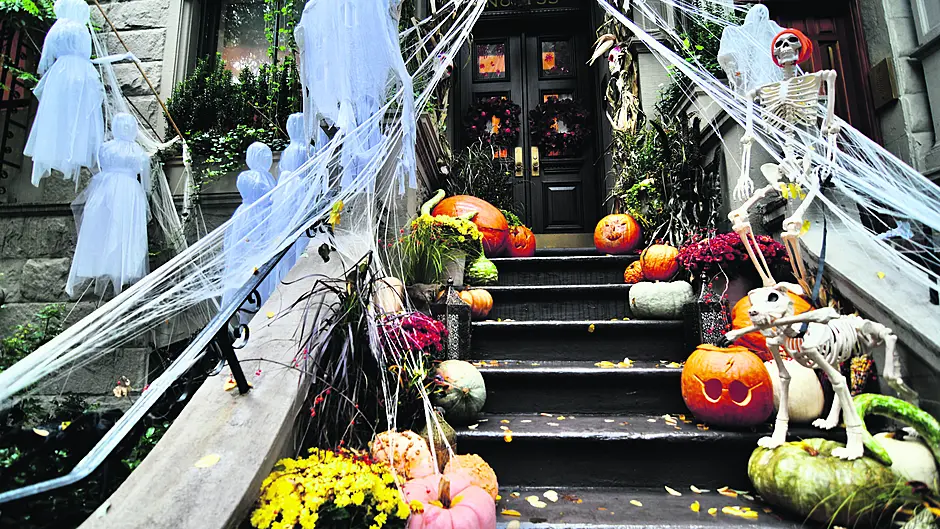
Probing the murky origins of our annual brush with the spirit world, we unearth some curious comparisons with how the eerie festival is marked in West Cork in modern times
ROOTED in the great pagan festival of Samhain, Hallowe’en (evening of All Hallows) is ‘about welcoming the dead’, explains Clodagh Doyle from National Museum of Ireland.
‘You would leave out a bit of a meal, maybe for deceased members of the family, you believe that people might be travelling back, and leave a candle in the window so they can find their way home … a cross and Hallowe’en water could get you through the winter without illness or poverty.’
Folk believed you could foretell the future at Hallowe’en.
Find a coin in your barmbrack and you’d become rich, a ring and you’d marry (a pea, not this year), a crucifix and you’d take up religious orders.
But if you chanced across a rag you’d be poor, a button you’d remain a bachelor, a thimble a spinster. God forbid you found a matchstick: your spouse would beat you.
Today’s lighted pumpkins perhaps originated from a story about mean farmer ‘Stingy Jack’, who invited the Devil for a tipple.
Unwilling to pay for it, he got him to turn into a coin to buy their drinks. Jack then pocketed the money. When he died, the Devil refused Jack entry to Hell, and sent him into the dark to join the creatures of the night, with only a burning coal to light his way. Placing it into a carved-out turnip, Jack has roamed the earth ever since.
Apart from the making of Jack O’Lanterns, advertisements in The Southern Star reveal a host of fiendish stunts to immortalise Hallowe’en locally: teas were brewed past midnight in Courtmacsherry in 1979, while Kilbrittain conjured up four days of showband magic.
On the dancefloor of Bantry Bay Hotel you could ‘rattle your bones’ and have a ‘howling good time’ in 1989. In more recent years, Carrigaline children were read spine-tingling tales from The Spider’s Web (2002), and those from Ballinspittle were spooked by a haunted house and a ‘scary dog’ fancy dress show (2012).
Fyffes colouring competition (1998) awarded as prizes ‘Banacula masks’ and ‘banana fangs’, Dracula-style. Another art tournament: ‘Ghosts and Ghouls Come Out to Play’, run by Schull Community Pre-School (2008), encouraged ‘the wildest imaginings to be committed to paper’. Two Hallowe’ens later, they manifested themselves in phantoms and witches that ‘flitted around the main street’, scaring the pants off locals.
There are those who believe it’s time to say goodbye to Hallowe’en, the Devil’s holiday, a celebration of the power of evil over good, a time of nasty tricks. Others say it’s become too commercialised, with patterned pumpkins, fake blood and Gothic goblets. It’s also an excuse for pretty awful behaviour. Some fear to open the front door, or worry their ‘treat’ won’t be appreciated.
Garda warned parents last year to take care their children didn’t trip up on billowing costumes, or run out from behind parked cars.
One Schull resident complained: ‘Again Hallowe’en offered the weaker-minded youngsters around town an excuse to throw eggs at innocent householders’, while others took the opportunity to conduct ‘more felonious activity’– all under the cover of ‘this wretched festival’.
SIX WEIRD FACTS ABOUT HALLOWE’EN
• Famous magician Harry Houdini, the ‘Genius of Escape’, evaded many things but could not cheat death – on Hallowe’en, October 31st 1926. The circumstances surrounding his sudden demise are mysterious. Some attribute it to poisoning by fellow spiritualists.
• Chicago City Council banned Hallowe’en in 1942. Wartime sugar rationing meant trick-or-treating was not viable, and ringing doorbells ‘disturbed tired war workers’.
• In the 1978 horror film Hallowe’en starring Jamie Lee Curtis, the slashing sound effects are made by plunging a knife into a watermelon – not a pumpkin, to sound more like a skull splitting.
• In 2013, a whopping 30,581 Jack O’Lanterns were displayed in the City of Keene, New Hampshire. Each was properly carved and stayed alight for five minutes.
• In Walnut Creek, California, to prevent criminal activity during
Hallowe’en celebrations, you must ask the sheriff for a permit before donning a mask in public.
• Anxious what Hallowe’en might bring? Perhaps you’re suffering from Samhain-ophobia. You’d be in good company. The all-embracing fear of these scary shenanigans is as old as the Samhain festival itself.
HAVE A HAPPY HALLOWE’EN!







